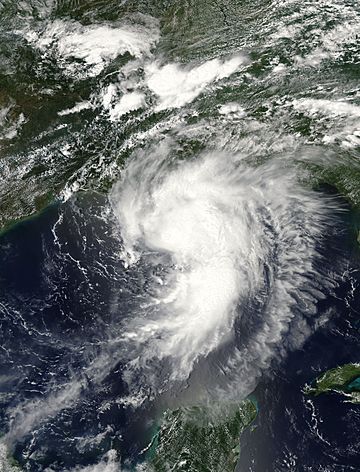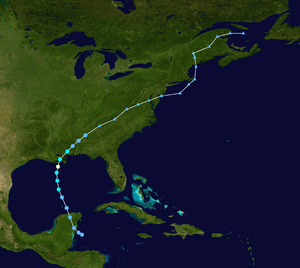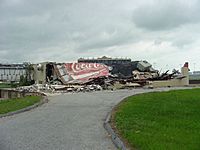Hurricane Cindy (2005) facts for kids
| Category 1 hurricane (SSHWS/NWS) | |

Hurricane Cindy on July 6, 2005.
|
|
| Formed | July 3, 2005 |
|---|---|
| Dissipated | July 7, 2005 |
| Highest winds | 1-minute sustained: 75 mph (120 km/h) |
| Lowest pressure | 991 mbar (hPa); 29.26 inHg |
| Fatalities | 1 direct, 2 indirect |
| Damage | $320 million (2005 USD) |
| Areas affected | Yucatán Peninsula, North Carolina, South Carolina, Alabama, Mississippi, Louisiana |
| Part of the 2005 Atlantic hurricane season | |
Hurricane Cindy was a tropical storm that grew into a hurricane for a short time in July 2005. It formed in the Gulf of Mexico and hit Louisiana. Cindy was the third named storm and the first hurricane of the 2005 Atlantic hurricane season.
At first, experts thought Cindy was only a strong tropical storm. But after looking at the storm's data again, they realized it briefly became a Category 1 hurricane.
Hurricane Cindy started on July 3, 2005, near the Yucatán Peninsula. It moved into the Gulf of Mexico and got stronger. Cindy made landfall in southern Louisiana on July 5. The storm then weakened as it moved over land and disappeared by July 7.
Cindy caused three deaths in the United States. It also brought heavy rain to states like Louisiana, Mississippi, Alabama, and Maryland. A strong F2 tornado formed from Cindy's leftover energy. This tornado caused a lot of damage in Hampton, Georgia. Cindy also led to flooding and a big power outage in New Orleans, Louisiana. This experience made many people in New Orleans decide to leave when Hurricane Katrina hit the city the next month.
Contents
Cindy's Journey: How the Storm Moved
A strong weather system, called a tropical wave, started near Africa on June 24. It moved quickly across the Atlantic Ocean but did not get stronger right away. As it reached the Caribbean Sea, it became more organized.
From Tropical Wave to Depression
Late on July 3, this system became Tropical Depression Three. It was about 80 miles (130 km) east of Chetumal, Mexico. Weather experts had trouble predicting where it would go next. Some thought it might even hit Texas.
The depression quickly grew stronger before hitting the Yucatán Peninsula early on July 4. Its winds were about 35 mph (55 km/h). Cindy then lost most of its strength as it moved over land.
Cindy Enters the Gulf of Mexico
Later on July 4, a new center of the storm began to form as Cindy entered the Gulf of Mexico. This change made experts update their predictions, now pointing to Louisiana as the likely landfall spot.
The depression moved north in the Gulf of Mexico. It became Tropical Storm Cindy early on July 5. The storm continued to strengthen as it got closer to Louisiana.
Becoming a Hurricane and Landfall
For a very short time, Cindy became a minimal hurricane with winds of 75 mph (120 km/h). It made landfall near Grand Isle, Louisiana late on July 5. Even though it was first thought to be only a tropical storm, later studies confirmed it was a hurricane.
Hurricane Cindy then weakened back into a tropical storm as it moved over southeastern Louisiana. It made a second landfall near Waveland, Mississippi, with winds of 50 mph (85 km/h) on July 6. Cindy continued to move northeast over Mississippi and Alabama. It weakened to a tropical depression that same day. The depression became a non-tropical storm over South Carolina on July 7 and disappeared in the Atlantic Ocean by July 9.
What Happened: Cindy's Effects on Land
Hurricane Cindy caused power outages for about 300,000 homes and businesses. This happened in southeastern Louisiana and along the Mississippi coast. The storm also brought a storm surge, which is a rise in sea level, of 4–6 feet (1.2-1.8 meters) to the same areas. This led to some erosion on the beaches in southern Louisiana.
Impact in New Orleans
In New Orleans, Louisiana, wind gusts reached 70 mph (110 km/h). Many trees were damaged or fell over, and streets flooded. Thousands of people lost electricity. The city had its worst power outage since Hurricane Betsy, which happened 40 years earlier. Even though Cindy was officially a "Tropical Storm" at the time, many people in New Orleans called it "Hurricane Cindy" because of how strong it felt.
Damage from Tornadoes and Rain
Even after Cindy weakened to a depression and moved far inland, its effects were still felt. Parts of the Atlanta Motor Speedway and Tara Field airport in Hampton, Georgia, were badly damaged. This damage came from an F2 tornado that formed because of the storm.
Hartsfield–Jackson Atlanta International Airport in Atlanta received over 5 inches (130 mm) of rain on July 6. This was the sixth-highest one-day rainfall there since 1878. Most of this rain fell in just two hours. This amount of rain is more than Atlanta usually gets in the entire month of July! Many other places, like Slidell, Louisiana, Gulfport, Mississippi, Mobile, Alabama, and Salisbury, Maryland, also saw over 5 inches (125 mm) of rain.
Fatalities and Lessons Learned
Cindy was linked to three deaths. Two happened in Georgia (one directly caused by the storm) and one in Alabama.
Many people in the New Orleans area thought Cindy would only cause minor problems. But they ended up cleaning up messes and were without power for days. This experience taught many people a valuable lesson. It encouraged them to leave the city when the much stronger Hurricane Katrina headed their way less than two months later.
Why Cindy's Name Will Be Used Again
When Tropical Storm Cindy formed on July 5, it was the seventh time this name had been used for a storm in the Atlantic. Because Cindy did not cause a lot of major damage, its name was not removed from the list. The World Meteorological Organization decides which storm names are retired. Cindy's name will be used again for future storms in the 2011 season.
Related pages
- The HPC's archive on Hurricane Cindy .
|
Tropical cyclones of the 2005 Atlantic hurricane season |
|||||||||||||||||||||||||||||||||||||||||||||||
|
|
||||||||||||||||||||||||||||||||||||||||||||||
|
|
|||||||||||||||||||||||||||||||||||||||||||||||
Images for kids
-
Hurricane Cindy making landfall over Louisiana on July 6
See also
 In Spanish: Huracán Cindy (2005) para niños
In Spanish: Huracán Cindy (2005) para niños




